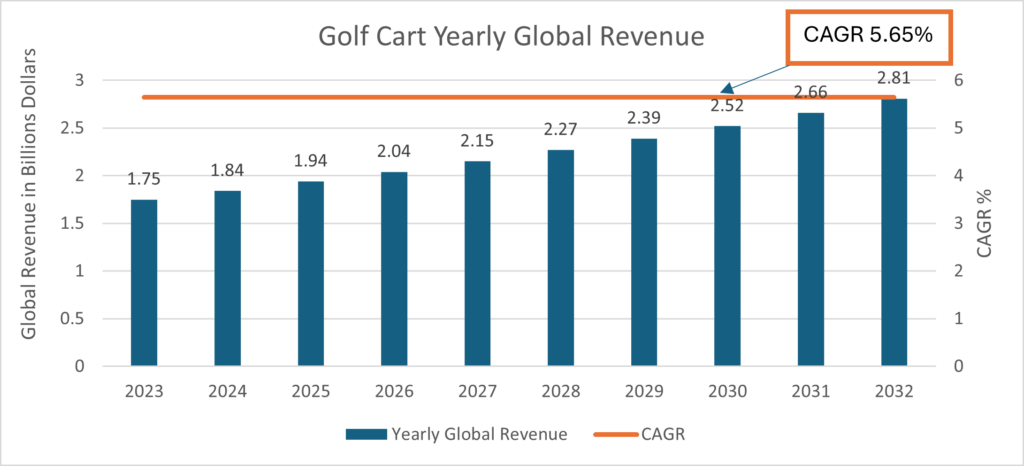
Power Systems Research estimates the Global Golf Cart Market to be $1.84 billion in 2024 and expects this market to reach $2.81 billion by 2032, growing at a CAGR of 5.65% during the forecast period.
Market Demand Drivers. Theincreased popularity of the game of golf by senior citizens, women, and juniors has increased the demand for golf carts. The increased use of these eco-friendly electric vehicles by government and industry also has pushed demand.
- Sustainability and Environmental Concerns. Governments, golf courses, and consumers increasingly are emphasizing the need for eco-friendly alternatives. Electric golf carts, with their lower emissions and reduced environmental impact, meet these concerns.
- The solar golf cart segment is projected to experience rapid growth, primarily due to its eco-friendly nature and lower operating costs.
- Popular golf destinations and resorts experienced an influx of tourists, and millions of new participants have started golfing for the first time are leading to higher demand for golf carts.
- Increased participation. More than 2 million newcomers have been added to the industry for eight consecutive years between 2012 and 2019, with the number exceeding 3 million per year between 2020 and 2022.
Trends. Individual owners of golf carts, especially in senior residential golfing communities in the South, are customizing their golf carts and adding special features to the units. Golf courses also are upgrading, adding features such as GPS units.
- Customization and Personalization. Manufacturers offer a range of customization options, allowing golfers and golf course operators to tailor the carts according to their preferences.
- Integration of Smart Features. GPS systems, touchscreens, Bluetooth connectivity, and mobile app integration became increasingly common in golf cart models. These features provided golfers with real-time course information, scoring capabilities, and entertainment options, enhancing the overall golfing experience.

Source: Power Systems Research
Market Restraints. Costs and charging limits are slowing the growth of this segment.
- High Initial Cost. The high initial cost of golf carts remained a significant restrain. The price of golf carts, especially electric models with advanced features, can be expensive for individual consumers and small golf courses. This high pricing limited the adoption of golf carts, especially in price-sensitive markets.
- Limited Charging Infrastructure. The limited availability of electric charging infrastructure was a restraint for the widespread adoption of electric golf carts. While the demand for electric models increased, the lack of charging stations and infrastructure in certain areas restricted the practicality and range of electric carts. The need for a robust charging network remains crucial for the continued growth of electric golf carts.
PSR Analysis. The global golf cart market is characterized by a competitive landscape with several key players vying for market share. These companies focus on product innovation, strategic partnerships, and expansion strategies to gain a competitive edge in the market.
Key players compete based on factors such as product quality, pricing, performance, innovation, and customer service. They engage in strategic collaborations, mergers and acquisitions, and geographic expansions to strengthen their market position.
Manufacturers are investing in the development of advanced technologies such as connectivity, autonomous capabilities, and energy efficiency to stay competitive in the evolving golf cart market. PSR
Michael Aistrup is a Senior Analyst at Power Systems Research

